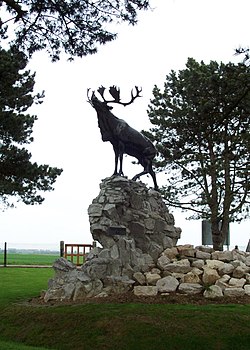Coordinates: 50°3′54.31″N 2°51′13.24″E / 50.0650861°N 2.8536778°E
| Gueudecourt Memorial | |
|---|---|
| Canada (formerly Dominion of Newfoundland) | |
 The Newfoundland Gueudecourt Memorial | |
| For the actions of the Royal Newfoundland Regiment during the First World War Battle of Le Transloy. | |
| Location | near Gueudecourt, France |
| Gueudecourt 1916 | |
The Gueudecourt Memorial is a Dominion of Newfoundland war memorial that commemorates the actions of the Royal Newfoundland Regiment during the Battle of Le Transloy, a sub-battle of the Battle of the Somme of World War I. Located about one kilometre northeast of Gueudecourt village, the memorial marks the spot where in October 1916 the Royal Newfoundland Regiment's played a decisive role in the capture and holding of a German strong-point. The site also marks the furthest point of advance from the July 1st starting line of all British units during the Battle of the Somme.[1]
Background[]
Following the regiments almost complete demise during the first day of the Battle of the Somme, the Newfoundland Regiment continued to see service although the regiment remained significantly understrength. After taking on reinforcements the regiment was back in the front line on 14 July near Auchonvillers.[2] The Newfoundland Regiment along with entirety of the 88th Brigade was transferred to the Ypres Salient on 16 July 1916, which at that time was a quieter portion of the Western Front.[2] A period of recovery coupled with additional reinforcements would eventually help the regiment return to full strength. After spending 10 weeks in the Ypres Salient, the 88th Brigade was temporarily attached to the British 12th Division, which was holding Gueudecourt. By nightfall on October 10, the regiment was manning a 450-metre section of the trench on the northern outskirts of the village.
The battle[]
The attack began at 2:05 pm on 12 October 1916. The regiment advanced in line with the 1st Essex Battalion on their left. The men kept so close to the supporting artillery barrage that several became casualties from the shrapnel of their own supporting guns. Likewise, the Germans were compelled by the shelling to remain under cover and as a result were quickly engaged in hand-to-hand fighting. By 2:30 p.m. both assaulting battalions of the 88th Brigade had secured their initial objective, Hilt Trench in the German front line.
As the Newfoundlanders advanced to their final objective, Grease Trench some 750 metres from their starting line, heavy machine-gun fire coming from the front and the right flank forced the regiment back to Hilt Trench. On their left flank, a German counter-attack drove the 1st Essex Battalion back to the outskirts of Gueudecourt, leaving the Newfoundlanders with an open flank.[3] Newfoundland bombing parties cleared and secured the vacated portion of Hilt Trench and as a result doubled the length of the regiment's front line. All ranks began digging in the hard chalk to construct a new firing step and parapet and reverse the former German position.
In the late afternoon the expected German counter-attack developed, but Newfoundland suppressive rifle and Lewis machine gun fire managed to drive off the German attack. The position was held against further assaults and during the night of 12 October, the arrival of a relieving battalion of the 8th Brigade enabled the Royal Newfoundland Regiment to hand over their responsibilities and go into reserve. During the 55 hours that had elapsed since they had entered the trenches on October 10, the Newfoundland Regiment had suffered 239 casualties, of whom 120 had been killed or would die of wounds. The Regiment had however been one of the few units on the whole of the British Fourth Army front to capture and retain its objective.
Memorial[]
The memorial is one of six memorials erected by the Newfoundland government following the First World War. Five were erected in France and Belgium and the sixth at Bowring Park in St. John's, Newfoundland, Canada.[3] The memorial is a bronze caribou, the emblem of the Royal Newfoundland Regiment, standing atop a cairn of Newfoundland granite. The mounds are also surrounded by native Newfoundland plants.
The Gueudecourt Memorial is situated on the D574 road, about one kilometre northeast of the village on a site that was the British front line of 17 November 1916, the final day of the British offensive at the Somme. Clearly visible behind the caribou as seen from the memorial's entrance is a preserved trench line. The area in which the memorial stands was seized by Newfoundland troops from the Germans on 12 October 1916 and marks the farthest point of advance of British units during the Battle of the Somme.[3]
Notes[]
- ↑ Jacqueline Hucker (2012). "Monuments of the First and Second World Wars". The Canadian Encyclopedia. Historica Foundation. http://www.thecanadianencyclopedia.com/articles/monuments-of-the-first-and-second-world-wars. Retrieved 2012-07-26.
- ↑ 2.0 2.1 Nicholson p. 284
- ↑ 3.0 3.1 3.2 Busch 2003, p. 151.
References[]
- Busch, Briton Cooper (2003). Canada and the Great War: Western Front Association Papers. Montreal: McGill-Queen's University Press. ISBN 0-7735-2570-X.
External links[]
| ||||||||||||||||||||||||
The original article can be found at Gueudecourt (Newfoundland) Memorial and the edit history here.